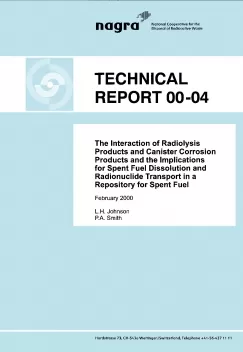
Technical Report NTB 00-04
The Interaction of Radiolysis Products and Canister Corrosion Products and the Implications for Spent Fuel Dissolution and Radionuclide Transport in a Repository for Spent Fuel
In this report, the release of radionuclides from the engineered barrier system of a deep geological repository for spent fuel is discussed and quantitative models are presented that will be used to support the concepts, models and parameter values to be used in future Nagra performance assessments. In the Nagra repository concept, the spent fuel will be contained in massive steel canisters, or copper canisters with steel inserts, that should ensure complete containment of radionuclides for at least 1000 years. When a canister is eventually breached, and water contacts the fuel, rapid release of an “instant release fraction” occurs, together with the much slower release of radionuclides incorporated in the fuel matrix, as the matrix dissolves. Processes that affect matrix dissolution include the failure of the Zircaloy cladding, the radiolysis of water contacting the fuel, with the generation of radiolytic oxidants that may react with the fuel, and the production of Fe2+ and H2 from the corroding canister, that may scavenge radiolytic oxidants, and may also reduce the U(VI) released during fuel dissolution.
The failure of Zircaloy cladding is discussed. It is concluded that oxidants produced within the thin films of water surrounding the fuel pellets would have difficulty escaping by diffusion through the failed cladding. This provides the basis for a model of spent-fuel dissolution, in which it is assumed that all radiolytic oxidants that do not recombine with radiolytic reductants, react with the fuel surfaces. In order to apply this model, it is necessary to obtain a value for the effective yield of oxidants due to radiolysis, expressed as an effective G-value, that is suitably conservative for performance-assessment purposes. This report reviews evidence from laboratory experiments and natural analogues and concludes that a conservative value for performance-assessment calculations is 0.01 molecules of H2O2 per 100 eV.
If they are not scavenged by reductants inside the canister, such as H2 and Fe2+, radiolytic oxidants, and U(VI) from the dissolved fuel, may migrate from the breached canister into the surrounding bentonite buffer. The reducing minerals present in the bentonite, such as pyrite and siderite, will be depleted by these oxidants, forming an oxidising region, bounded by a redox front. Within this region, the solubilities of some safety-relevant radionuclides may be increased, and sorption diminished. For performance assessment, it is therefore important to assess the likely maximum penetration of the redox front.
In order to assess the scavenging by Fe2+, the corrosion of carbon steel is reviewed and a model presented for the release of Fe2+ from a corroding steel canister. Release of Fe2+ occurs when iron corrodes to magnetite, but iron may be passivated by the formation of a low-porosity layer of maghemite on the magnetite. This model is incorporated in an assessment of the redox-front migration from a canister that is breached, either at a point or, more realistically for the assumed canister design, at a circumferential crack. The production of radiolytic oxidants decreases as a function of time, whereas the production of Fe2+ initially decreases but increases at longer times as a result of the formation of high surface area corrosion deposits. Eventually, all oxidants that are produced are likely to be scavenged. The time at which production of Fe2+ first exceeds that of radiolytic oxidants is also that time at which the oxidising region reaches its maximum extent.
The report presents calculations of redox-front penetrations for different fuel types (UO2 and MOX fuels with a range of burn-ups) and for different assumptions regarding the nature of reductants in the bentonite and different canister lifetimes. It is concluded that the scavenging of radiolytic oxidants by Fe2+ from canister corrosion is an important mechanism in limiting the extent of the oxidising region, but that it is also important to establish whether credit may be taken for the full potential of pyrite in the bentonite to provide a further scavenger of radiolytic oxidants.
